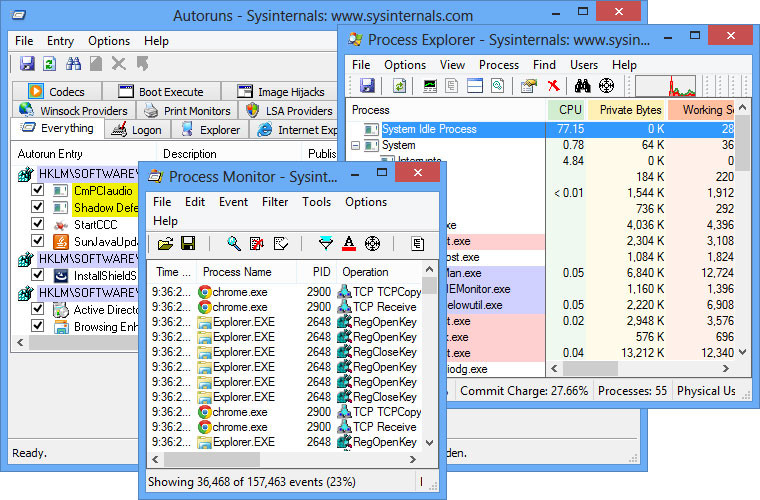
#Sysinternals memory monitor update#
This update fixes a memory leak for DLL image load event monitoring and removes a misleading warning when processing configuration files.ĪDInsight, a real-time monitoring tool, now includes support for 64-bt Windows as well as numerous bug fixes. Sysmon is a system utility that logs security relevant process, network and file events to the event log.
#Sysinternals memory monitor windows 10#
This release of RAMMap, a tool that reports detailed information about physical memory usage, is compatible with Windows 10 and includes a bug fix that could cause a crash when a long file name was scrolled into view in the file summary page.īgInfo, a utility that displays customization text and system information on the desktop wallpaper, now correctly reports Windows 10 and Windows Server 2016, and fixes a bug that could cause incorrect desktop bitmap sizes on systems with high DPI. Sigcheck, a command-line utility for displaying detailed file version information, image signing status, catalog and certificate store contents, includes updated Windows 10 certificate OIDs, support for checking corresponding MUI (internationalization strings) files for more accurate version data, and now shows the version company name as well as signature publisher for signed files. This update to Autoruns, the most comprehensive autostart viewer and manager available for Windows, now shows 32-bit Office addins and font drivers, and enables resubmission of known images to Virus Total for a new scan. Sinds de vorige editie zijn de volgende onderdelen van de Suite bijgewerkt: Autoruns v13.5 Overigens kunnen de laatste versies van de afzonderlijke programma's zoals altijd ook hier worden gevonden. In totaal gaat het om een verzameling van 70 verschillende tools. Enkele voorbeelden zijn Process Explorer, Bginfo, Contig en Diskmon. Zo kunnen allerlei problemen worden opgespoord en verholpen.ĭe afzonderlijke tools worden ontwikkeld door Mark Russinovich en Bryce Cogswell, in eerste instantie voor Sysinternals en sinds 2006 voor Microsoft. Click on Computer Management snap-in in the Context menu. Press the Win + X key to open the WinX menu. Dit pakket is een verzameling handige tools waarmee systemen kunnen worden beheerd en waarmee uitgebreide informatie over de computer kan worden ingewonnen. You can also use it to open Performance Monitor in Windows 11. I resolved the issue by following the guidance in the Microsoft workaround above by opening regedit and changing the value of the DisableIdleStop DWORD from 0 to 1 and rebooting the servers.Microsoft heeft een nieuwe versie van de Sysinternals Suite de deur uitgedaan, met de datum als versienummer.

The culprit turned out to be the Remote Registry service. The Windows Notification Facility tag was using a lot of memory!Īfter looking online I found that Microsoft has acknowledged this as a problem for Windows Server 20 R2. I downloaded the Windows WDK and used PoolMon located in C:\Program Files (x86)\Windows Kits\10\Tools\圆4 to inspect the paged memory on one of the servers and I found the following:

However on Server 2 just before I was about to restart it, it was 6.7GB…. Whilst in Task Manager on the first server after rebooting it, I noticed the paged pool was only around 200MB. Just to check, I compared this to DNS servers from other forests in different environments and they were around the same. I turned my attention to the current handles in the system but the highest amount was from the DNS service. I downloaded RamMap from the Sysinternals suite which allowed me to look at files being stored in the memory. I checked Resource Monitor on one of the servers and the highest consumer was the lsass.exe process but it wasn’t really consuming that much memory. They were A2_v2 specification running 2 vCores and 4GB of memory.Īfter about 5 hours of uptime, both servers would be using 3.9 of 4GB memory. One of our customers recently had an issue with 2 of their 2012 R2 domain controllers running in Azure.


 0 kommentar(er)
0 kommentar(er)
